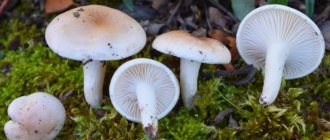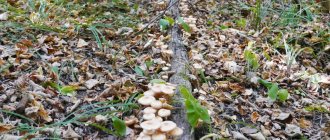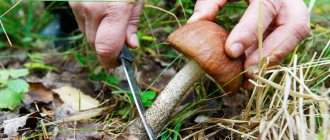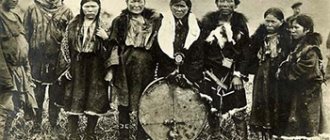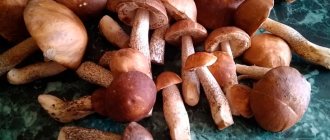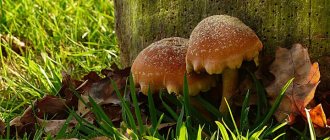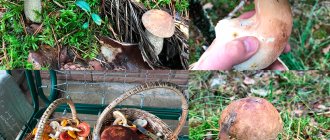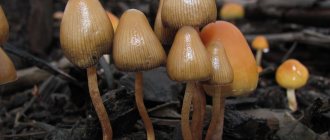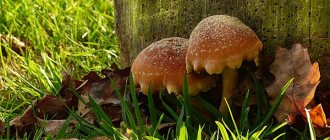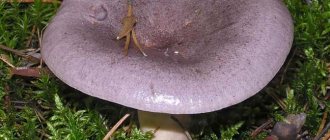Late hygrofor has good taste and a pleasant aroma. Mushroom pickers often avoid collecting real fruiting bodies, despite the fact that some types of these mushrooms can be classified as delicious. They are suitable for all types of heat treatment. In addition, they can be stored for the winter.
These mushrooms have many similarities with less valuable and even poisonous varieties, therefore, despite their high prevalence in nature, mushroom pickers often hesitate to take them into their basket.
Short description
| Type of mushrooms: | edible |
| Other names (synonyms): | Hygrophorus brown, Woodlice, Slastena |
| Latin name: | Hygrophorus hypothejus |
| Family: | Hygrophoraceae |
| Distinctive feature: | Hygrophorus late - appears in late autumn in coniferous forests, often with the first frosts. |
| Beginning of the season: | October |
| End of season: | December |
| Leg height (cm): | 5-10 cm |
| Cap width (cm): | 3-5 cm |
| Smell: | not expressed |
| Taste: | pleasant, sweetish |
| Tasting score: | [kkstarratings] Have you tried this mushroom? Then rate it! |
| Hat: | at first convex with a tucked edge, later spread out, with a small tubercle in the center, the edge remains down for a long time. The surface is smooth, slimy. The color of the caps of young fruiting bodies is uniform olive-brown, yellow-brown; with age, the edge lightens to yellow-ocher, yellow-orange. |
| Leg: | cylindrical, usually slightly narrowed downwards, solid, sometimes hollow in old fruiting bodies. Color ranges from white to straw yellow, sometimes with orange tints. In the upper part of the stalk there is a thin mucous ring. Above the ring the leg is dry, dusty, below it is mucous and smooth. |
| Hymenophore (bottom of cap): | the plates of the late Hygrophorus are sparse, thick, yellowish, weakly descending onto the stalk or adherent. |
| Disputes: | elliptical, (6.3) 7.2-9.3 x 4.2-5.9 µm |
| Pulp: | white or yellowish, darker near the surface of the cap, waxy consistency. |
| Natural environment and mycorrhiza: | in coniferous and mixed forests, adjacent to pine. |
| False doubles: | similar to Hygrophorus hypothejus, but has a distinctive striped leg. |
| Growing: | – |
| Use: | It is eaten fresh and pickled. |
| Medicinal properties: | – |
| Spreading: | Europe and North America. |
Description
This mushroom is a prominent representative of the Hygrophoraceae family. Its other names are brown hygrophor, sweet tooth, wood lice. After heat treatment it has a pleasant taste. The cap reaches 2-2.5 cm. In young fruits it has a flat shape. Color can vary from yellow-brown to olive. The surface is smooth and slimy.
The pulp of the mushroom is white, soft and has no unpleasant odor. The plates are sparsely located. They are distinguished by a yellowish tint. The thickness of the leg is about 0.5-1 cm. Its height reaches 4-10 cm. It has a cylindrical shape.
Time and place of fruiting
This type of fungus is most often found in coniferous and mixed forests of the temperate climate zone. Often creates symbiosis with pine. Fruiting bodies prefer to grow in areas covered with heather, moss or lichen. It is often difficult to detect the mushroom among vegetation and fallen leaves.
Hygrophorus brown belongs to the late ones. It begins to bear fruit in the second half of September. Fruiting bodies appear before the beginning of winter.
The mushroom is not afraid of frost, so it can be collected before the first snow. Under favorable conditions, group shoots are observed.
How to distinguish edible Sweets from inedible ones
The entire Hygroforaceae family belongs to edible mushrooms. There are no poisonous species among them. Conditionally edible hygrophores need to be cooked longer to remove the bitterness. When collecting, you need to take into account the main external characteristics of Slastena:
- slippery, highly shiny cap;
- small size (average cap diameter - 3 cm);
- the darkest color of the cap is in the center;
- The center of the cap of young mushrooms is flat or cone-shaped, of adults – depressed.
It also helps in discrimination that Slastena can be collected in extreme cold, when there are simply no other mushrooms.
Growing at home and in the country
Hygrofor brown can be grown not only in the country, but also on the balcony of the apartment. However, to obtain a good result, many requirements must be met.
Mycelium can be planted both in open ground and in specially prepared boxes with soil mixture.
Hygrophora spore powder can be purchased at a specialty store. It must be mixed with sand in a ratio of 1:5. This will make the planting process easier.
In open ground, spore powder is planted near old fruit trees. It is best to plant mushrooms in mid-spring. At the planting site, you need to loosen it well to a depth of 10 cm.
After this, it is necessary to distribute the spores mixed with sand in the prepared holes. Humus and a layer of soil should be laid on top.
After this, it is necessary to water the planting site generously, using at least 10 liters of water per 1 m². In the future, you need to water every 2-3 days. In most cases, the first harvests can be obtained within a few years. In rare cases, mushrooms appear in the fall.
To speed up the onset of fruiting, you need to fertilize the area where the mycelium was sown with humus. It is not recommended to apply chemical fertilizers, as they can accumulate in the developing fruiting bodies, poisoning them.
In addition, you can grow hygrophores in a basement, cellar or other suitable room where it is possible to maintain air circulation, high humidity and the required temperature.
Compost preparation
It is permissible to use wort, carrot or oat agar as a nutrient medium. In addition, it is necessary to prepare the substrate for growing mushrooms in advance. It can be compost. To prepare it, you should mix 100 kg of dry straw, about 60 kg of horse or cow manure, 2 kg of superphosphate and urea, 5 kg of chalk and 8 kg of gypsum. First, the straw should be soaked for 2-3 days, and then layered with manure. Urea and superphosphate must be added to each layer.
The place where composting will be carried out must be well ventilated, but it must be protected from precipitation and soil ingress. You need to water the compost every day with water at room temperature. After about a week, all layers should be mixed.
In the future, you need to carry out this procedure every 3-4 days. 5 days before the compost is ready, chalk and gypsum should be added to the composition. The process of its preparation takes 20-25 days. The mixture should become soft and loose. It shouldn't stick to your hands.
After this, the finished compost should be placed in boxes or bags prepared in advance. After about 2-3 days, when the temperature of the compost drops to +23...+25°C, you can plant the spore powder. Disembarkation is carried out in a checkerboard pattern. The distance between the holes should be at least 20 cm. Be sure to cover the places where you put compost. After this, the substrate is watered abundantly.
The air humidity in the room should be at least 75-90%. The recommended temperature is +23…25°C.
After about 2 weeks, white cobwebs of forming mycelium will appear on the surface of the substrate. They need to be ground with a mixture of peat, limestone and earth. After 3-5 days, the room temperature should be reduced to +12...17°C. The first harvest will appear in 2-3 months.
The substrate can be used for no more than a year. After this, it is recommended to replace it with fresh compost. Before adding fresh material, it is imperative to treat the containers in which hygrophores were grown with a solution of bleach.
Definitioner
Basidia (Basidia)
Lat. Basidia. A specialized structure of sexual reproduction in fungi, unique to basidiomycetes. Basidia are terminal (end) elements of hyphae of various shapes and sizes, on which spores develop exogenously (outside).
Basidia vary in structure and method of attachment to hyphae.
Based on the position relative to the axis of the hyphae to which they are attached, three types of basidia are distinguished:
Apical basidia are formed from the terminal cell of the hypha and are located parallel to its axis.
Pleurobasidia are formed from lateral processes and are located perpendicular to the axis of the hypha, which continues to grow and can form new processes with basidia.
Subbasidia are formed from a lateral process turned perpendicular to the hyphal axis, which stops growing after the formation of one basidium.
Based on morphology:
Holobasidia are single-celled basidia, not divided by septa (see Fig. A, D).
Phragmobasidia are divided by transverse or vertical septa, usually into four cells (see Fig. B, C).
By type of development:
The heterobasidium consists of two parts - the hypobasidium and the epibasidium developing from it, with septations (see Fig. C, B) or without them (see Fig. D).
Homobasidia is not divided into hypo- and epibasidia and in all cases is considered to be holobasidium (Fig. A).
The basidium is the site of karyogamy, meiosis, and the formation of basidiospores. Homobasidy, as a rule, is not functionally divided, and meiosis follows karyogamy. However, the basidia can be divided into probasidium, the site of karyogamy, and metabasidium, the site of meiosis. Probasidium is often a resting spore, for example in rust fungi. In such cases, the probasidium germinates into a metabasidium, in which meiosis occurs and on which basidiospores are formed (see Fig. E).
See Karyogamy, Meiosis, Hypha.
Pileipellis
Lat. Pileipellis, skin - a differentiated surface layer of the cap of agaricoid basidiomycetes. The structure of the skin in most cases differs from the inner flesh of the cap and may have a different structure. The structural features of pileipellis are often used as diagnostic characters in descriptions of fungal species.
Based on their structure, they are divided into four main types: cutis, trichoderma, hymeniderma and epithelium.
See Agaricoid fungi, Basidiomycete, Cutis, Trichoderma, Hymeniderma, Epithelium.
Pileipellis (Pileipellis)
Lat. Pileipellis, skin - a differentiated surface layer of the cap of agaricoid basidiomycetes. The structure of the skin in most cases differs from the inner flesh of the cap and may have a different structure. The structural features of pileipellis are often used as diagnostic characters in descriptions of fungal species.
Based on their structure, they are divided into four main types: cutis, trichoderma, hymeniderma and epithelium.
See Agaricoid fungi, Basidiomycete, Cutis, Trichoderma, Hymeniderma, Epithelium.
Ixotrichoderma
Trichoderma, consisting of hyphae immersed in mucus. The surface of the cap is oily, slippery or slimy.
Lat. Ixotrichoderm.
See Trichoderma, Hypha.
Ixocoutis
Cutis, consisting of hyphae immersed in mucus. The surface of the cap is oily, slippery or slimy.
Lat. Ixocutis.
See Kutis, Gifa.
False and poisonous doubles
Brown hygrophorus is most often confused with deciduous. These mushrooms are similar in appearance, but the latter differs in the lighter color of the cap. Both varieties are edible. In some places, late hygrophores grow in large groups. Because of this, they can be easily confused with false honey mushrooms, especially if mushrooms are collected in rainy weather. False honey mushrooms are poisonous.
Medicinal properties, benefits and possible harm
It is believed that late hygrophores have a number of healing properties due to the presence of such active components in this mushroom as:
- lysine;
- proteins;
- cellulose;
- iron;
- calcium;
- cysteine, etc.
Regular use of this variety helps normalize the functioning of the central nervous system. It is believed that hygrophores can improve the functioning of the gastrointestinal tract. Biologically active substances contained in mushrooms have a normalizing effect on the functioning of the lymphatic system.
Replacing meat with hygrophores helps reduce the risk of developing obesity and type 2 diabetes.
The active substances contained in the fruiting bodies of hygrophores help improve liver function and suppress inflammatory processes in the human body.
With regular use of hygrophores, kidney function improves. The active substances contained in the fruits have a tonic effect on the human body.
In addition, regular consumption of mushrooms improves the condition of blood vessels and reduces the risk of developing heart disease. Biologically active compounds contained in hygrophores help improve eye condition.
Despite the fact that these mushrooms can bring great benefits to the body, it is still recommended to consume them in doses. Excessive consumption of hygrophores can cause metabolic disorders. In addition, while taking hygrophores, allergic reactions may occur.
In some cases, excessive inclusion of these mushrooms in food can provoke the development of hypervitaminosis. It has been observed that the use of this product worsens the condition of some people suffering from epilepsy.
The increased concentration of protein in this product, under some conditions, can cause deterioration in kidney function. It must be taken into account that hygrophores are capable of accumulating toxic substances, so fruits collected near landfills, highways, and factories can cause severe poisoning.
It is not recommended to abuse hygrophores for women during pregnancy and lactation.
Contraindications
Not everyone can eat mushrooms
Not everyone can eat hygrophores. The mushroom is contraindicated in the following cases:
- individual intolerance to the components of hygrophorus - it manifests itself in the form of nausea, vomiting, yellowness in the sclera of the eyes, salivation, stomach cramps, temperature rises, internal hemorrhage may occur;
- pregnancy and breastfeeding;
- epilepsy - headache, nausea, thoughts are confused, pressure changes occur, temperature rises, complexion changes.
Cooking methods
Using the best cooking recipes, you can delight yourself with delicious and healthy dishes every day. However, before we start frying and steaming hygrophores, we properly prepare the mushrooms for further processing.
To reduce the need to clean the fruit, during picking you should cut off the lower part of the stem and shake off any twigs and dirt that have stuck to the cap.
It is advisable to place hygrophores in the basket as clean as possible, since these mushrooms have delicate flesh that can break during intensive cleaning.
If you plan to heat treat or freeze the product in the future, it should be thoroughly washed, but if you want to dry the hygrophores, you should not soak them.
After coming home, you need to thoroughly rinse the harvested crop under running water and clean the mushrooms from sand and small debris with a brush. If the mushrooms are too dirty, it is recommended to carry out the washing procedure several times. Particular attention should be paid to the plates. After this, you need to put the hygrophores in a colander so that the water drains from them.
Cooking
Boiling hygrophorus allows you to reveal its taste. Mushrooms can be used to make soups and strong broths. For 1.5 liters of water you should take at least 200 g of mushrooms. The fruiting bodies must be thoroughly chopped. After this, they need to be poured into cold water and brought to a boil.
Be sure to salt the broth, add bay leaf, salt and peppercorns. The product should be cooked for 20 minutes.
3 minutes before the end of cooking, add a peeled onion to the broth. If a poisonous mushroom gets into the pan, the water will take on a bluish tint.
Pickling
If desired, you can quickly prepare pickled hygrophores at home. In order to prepare this dish, you will need:
- hygrophores – 1 kg;
- salt – 1 tbsp. l.;
- sugar – 2 tbsp. l.;
- allspice – 10 peas;
- vinegar - 4 tbsp. l.;
- boiled water -1 l.;
- vegetable oil – 4 tbsp. l.;
- cloves – 2-3 pcs.
To prepare the marinade, you need to mix water, spices, vinegar and vegetable oil. The mixture should be boiled for 5-10 minutes. After this, you need to place the mushrooms in boiling water and boil for 7 minutes.
Hygrophores must be infused for 5 hours. After this, the product is ready for use.
Freezing
If there are frozen mushrooms in the refrigerator, take them out and cook any dishes. Making such blanks is not difficult. After thoroughly cleaning and washing the fruits, they should be cut.
The preparations should be distributed into small portioned bags. This will avoid frequent defrosting and freezing of the product, which is necessary when packing into large briquettes.
After distributing the mushrooms into small bags or containers, place them in the freezer to freeze. Within a day, the product will have time to freeze well.
Frying
These mushrooms do not require pre-boiling before frying. The fruits should be finely chopped. After this, the frying pan must be thoroughly heated and vegetable oil poured into it. It is better to fry hygrophores with carrots and onions. First, chopped vegetables are placed in the pan. They need to be fried a little and then add the mushrooms.
Be sure to add salt and pepper to the dish. You need to fry the mushrooms for at least 30 minutes. 5 minutes before readiness, you can add a few tablespoons of sour cream or mayonnaise. This will improve the taste of the dish.
Pickling recipe
Hygrophores are often salted at home. For pickling, you need to take about 2.5 kg of fruiting bodies and 125 g of coarse salt. To pickle this product, it is better to use enamel dishes or wooden tubs.
Currant and horseradish leaves should be placed at the bottom. Mushrooms should be placed caps down in layers, sprinkling salt on each of them.
Additionally, you can add cherry leaves or currants, as well as allspice. The top of the hygrophores must be pressed down with pressure. After this, you need to put the container with the dish in the cellar. Salting should be carried out at a temperature not exceeding +15°C.
Drying and preserving for the winter
To dry, hygrophores should be cut into plates. After this, they need to be strung on a thick thread. Mushrooms should be hung in a well-ventilated area to dry. After about 3 weeks, you can move the hygrophores into a canvas bag for storage.
To prepare for the winter, you should first chop the hygrophores and boil them in salted water for at least 1 hour. Boiled mushrooms need to be boiled in another water for another 10 minutes. Water will need to be used as a marinade. Mushrooms need to be transferred to sterilized jars, poured with marinade and rolled up.
Is it possible to eat late hygrophor
Hygrophorus late is very similar in appearance to a toadstool. But in fact, this is a very tasty mushroom, suitable for all types of preparations. It can be salted, pickled and even frozen for the winter. Hygrophorus makes a very tasty soup. You can fry in a frying pan in two ways: with and without pre-boiling. Opinions differ among mushroom pickers, but the mushrooms turn out tasty and edible in both cases.
You need to cook hygrofor for no more than 15-20 minutes. At the same time, it turns out to be a little slippery. Then lightly fry and that will be enough. No need to add any spices other than salt. The mushroom is very tasty, it is not without reason that it is also called a sweet tooth. Hygrophores contain many nutrients and protein. This is what determines their high taste qualities. Here are some of them:
- vitamins A, C, B, PP;
- trace elements Zn, Fe, Mn, I, K, S;
- amino acids.
Attention! When frying, you need to be prepared for the mushrooms to release an incredible amount of moisture. It is better to drain the excess liquid immediately, without wasting time on prolonged evaporation.
There are different types of hygrophores, but the later ones can be immediately recognized by their brown cap and yellow plates
Video gallery
Video reviews
A selection of videos with descriptions and recipes for preparing mushrooms
Mushroom experts of the Russian Federation TV, Gribalka, about Mushrooms and Plants in Your Own Words
Interesting Facts
Not all lovers of quiet hunting can prepare hygrophores. This variety of mushrooms is notable for the fact that it does not bear fruit every year. In some regions, fruits appear en masse only once every 10-15 years. The reasons for this phenomenon have not yet been precisely established.
Information sources
- Dodik S. D. Mushrooms of Russian forests. M.: "AST", 2000
- Zerova M. Ya., Elin Yu. Ya., Koz'yakov S. M.
Mushrooms: natural, mentally natural, unnatural, destructive. — Kiev: Harvest, 1979
Where does it grow
The exact habitat in which Persona lives has not been established. It is found rarely, mainly near the mountains of the North Caucasus, in the Primorsky Territory, the Amur region and in some parts of Europe. It grows in hornbeam, broad-leaved and beech forests, often enters into symbiosis with oak, but can coexist with other trees. It bears fruits from August to November and grows in small groups, making it easier for mushroom pickers to collect several specimens.
